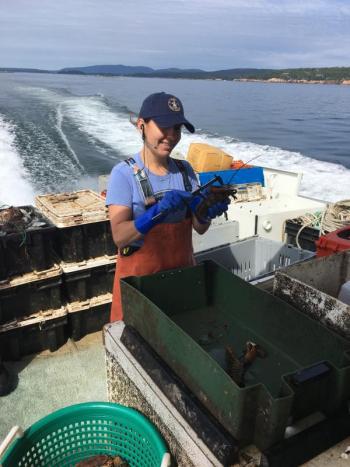From stern to stem, DMR scientist looks to the future of lobsters
While the lobster stock in Maine remains healthy and continues to grow, managing the future of the $300 million industry requires more than traditional science. In February, the Department of Marine Resources hired Katherine Thompson, a Ph.D. student in marine biology at the University of Maine, to lead its lobster sampling program.
Thompson, 31, is a New Harbor native and comes from a family steeped in fishing tradition. She operates from the DMR lab in West Boothbay and has the enviable task of calling the open ocean her office every week. Thompson is responsible for coordination, implementation and participation of the program in all seven of the state’s lobster management zones and oversees the department’s juvenile lobster ventless trap survey. Thompson’s responsibilities include supervision of DMR scientific staff and contractors who participate in those programs.
Her academic resume is tailored for the position. After graduating from college, Thompson completed an internship in lobster research through the Bigelow Laboratory in East Boothbay, focusing on the settlement index survey conducted by Richard Wahle of the University of Maine’s School of Marine Science. In 2013, Thompson received her master’s degree in living marine resource science and management from the University of Massachusetts-Dartmouth’s School for Marine Science and Technology. Her thesis project provided the first conclusive evidence of semiannual scallop spawning in U.S. waters on Georges Bank, which has important implications for management of the fishery. From 2013 to 2014, Thompson served as a supervisory research biologist for Coonamessett Farm Foundation, a scientific research and education foundation based in East Falmouth, Mass. In January 2015, she began her doctoral studies at the University of Maine, focusing on northern shrimp reproduction and distribution.
While the research is crucial, the opportunity is also a dream job for a local person well-versed in the culture of fishing. Both her father and great-grandfather were fishermen in New Harbor and she is a seventh generation Mainer on her father’s side. She served as a sternman in Round Pond during summers while she pursued a degree in biology from Smith College. In a bit of serendipity and foreshadowing, the boat she worked on participated in DMR’s ventless trap survey, providing her first experience with cooperative research.
“Growing up around a working waterfront definitely influenced my career,” said Thompson. “I think it was a natural course for me to pursue. I’ve intentionally done research that has directly collaborated with the lobster and scallop industries.”
This unique insight from both sides of the boat has allowed her to seamlessly bridge the gap between the two worlds of science and marine commerce. While there is a perception that fishermen cast a weary eye toward research, it’s not so, said Terry Lagasse, a lobsterman based in South Bristol who has been involved in the ventless trap survey for the past four years.
“It’s very informative,” said Lagasse. “It doesn’t hurt the stock.”
Lobstermen bid for the opportunity to participate and are compensated for their time. The trips can be as long as 90 miles; Lagasse’s 2016 survey leg went from Pemaquid to the New Meadows River.
“They measure all of the lobsters and you have to be able to go out in nasty weather,” he said.
The research trips can also be arduous with long days hauling traps and measuring, up to 11 hours on some days.
How is this research done and why is it important? According to the Department of Marine Resources, the sea sampling program places sea samplers onto commercial lobster boats to gather data on the nearshore lobster fishery. The ventless trap survey uses specially modified traps distributed along the coast to help the DMR characterize the juvenile lobster population in Maine waters.
Samplers measure the length from the rear of the eye socket to the rear of the carapace on a line parallel to the center line of the body shell. If the lobster is female, the samplers look for a man-made or natural notch located on the flipper to the right. After, the eggs are staged to determine what stage of development they are in. The eggs could be either freshly extruded or developing to the point where you can see the tiny eyes in the fully formed embryos, or hatching.
From May to November, Thompson will average four to six trips a month. The period from late fall through winter is typically reserved for entering, checking and uploading data and analysis.
“There are a ton of data,” said Thompson. “We supply one of the largest data stats for lobstering in Maine.”
The research suggests the lobster stock in Maine is healthy and not in immediate danger from disease and environmental changes that have resulted in the decline of the southern New England lobster industry. Lobsters are adaptive by nature, said Thompson, and have thus far survived and thrived in the cold Maine waters which serve as the optimal habitat for the crustacean. For now, the lobster industry is appears to be robust.
In the 11 years of the survey, the trend is encouraging; juvenile lobsters are plentiful, suggesting if survival is good, there will be an abundance of lobsters when they reach commercial size.
As for Thompson, her research is the logical extension of a curiosity and concern rooted in her upbringing.
“Any day on the water is a great one for me,” she said. “To be able to contribute in this industry makes it even better.”





























